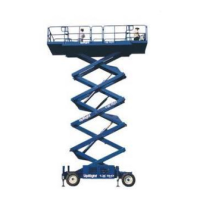LX 31/41 Work Platform
Operation
SectionSection
SectionSection
Section
3-1
3.0 Introduction
GENERAL FUNCTIONING
Closing the Upper and Lower Emergency Stop Switches,
selecting PLATFORM (OR CHASSIS) controls at the
Chassis/Platform Switch, starting the engine by turning
the Key Switch, and closing the Trigger Switch, will
energize the Power Relay (closing the circuit to the
Engine Ignition System (or diesel run solenoid), to the
Fuel Shut Off Solenoid, to the Fuel Pump, to the Fuel
Solenoid, and to the Function Relays), and the Throttle
Relay (increasing the Engine R.P.M.). This will turn the
Pump providing oil flow under pressure to operate all of
the functions of the work platform.
DRIVING
With Platform lowered
Selecting HIGH SPEED at the Torque Switch, DRIVE at
the Drive Lift Switch, and pushing the Control Handle
FORWARD or REVERSE will energize the Forward (or
Reverse) Relay, Forward (or Reverse) Solenoid Valve,
Platform Down Relay, Cutout Relay, Drive Relay (illumi-
nating the Drive Enable Indicator, if equipped), Series/
Parallel Relay, Series/Parallel Solenoid Valves, Shunt
Solenoid Valve (4WD), Axle Float Relay (4WD), Axle
Float Solenoid Valve (4WD), Joystick High Speed Enable
circuit (selecting high speed range), and the Proportional
Valve. This will allow oil pressure to unseat the Pilot
Check Valves in the Axle Float Cylinder (allowing the
Front Axle to float), allow oil to flow through the Propor-
tional Valve (regulating the speed to a rate which is
proportional to the angle of Control Handle deflection),
through the Forward Valve and the Brake Shuttle Valve
to the Brake Cylinder (releasing the brakes), through the
Series/Parallel Valves (directing the oil flow in series to
the rear Drive Motors), through the Shunt Valve (bypass-
ing the front Drive Motors), through the Reverse Coun-
terbalance Valve (preventing downhill runaway),
through the Reverse Valve, and back to the Hydraulic
Reservoir.
Selecting HIGH TORQUE at the Torque Switch, cuts
power to the Series/Parallel Relay, the Series/Parallel
Valves, or the Shunt Valve. This allows oil to flow in
parallel to the front two Drive Motors, and the rear two
Drive Motors which reduces the speed while increasing
the torque of the drive function.
Machines equipped with outriggers must have them
completely retracted (see Leveling the Platform).
3.0
With Platform elevated
With the Platform raised, the Platform Down Switch
opens which cuts power to the Platform Down Relay
(breaking the circuit to the Series/Parallel Relay, Series/
Parallel Valves, Shunt Valve (4WD), Axle Float Relay
(4WD), and Axle Float Valve (4WD)), the Cutout Relay
(Cutout Relay must now be energized by output from
the Level Sensor), and the Joystick High Speed Enable
circuit. This disables the high speed mode, locks the
Front Axle, and limits the Joystick to low speed range.
Braking
Dynamic braking of the work platform and runaway
protection on slopes is achieved hydrostatically by the
Forward and Reverse Counterbalance Valves. When
hydraulic pressure in the drive system drops below 800
psi, the Forward or Reverse Counterbalance Valve will
close blocking the flow of oil in the drive system. Mo-
mentum stored in the machine will then cause the
pressure to rise again above 800 psi when the Counter-
balance Valve will open and relieve it. When dynami-
cally braking, this process may cycle 3 to 4 times after
the control handle is released absorbing energy with
each cycle until the machine comes to a smooth stop.
Both Rear Wheels are equipped with spring applied
parking brakes which are hydraulically released when
driving.
Steering
Depressing the Steer Switch to the LEFT or to the
RIGHT will energize the Steer Left or Steer Right Relays
(completing the circuit to the Steer Left or the Steer
Right Solenoid). This will allow oil flow through the
Steer Orifice (limiting the speed), through the Steer
Valve (selecting direction), and to the Steer Cylinder
(turning the Front Wheels). Return oil from the Steer
Cylinder will flow back through the Steer Valve and out
to the Hydraulic Reservoir.

